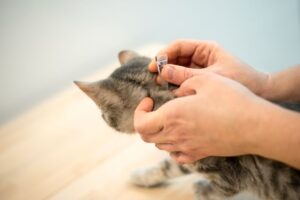It’s natural to worry if your dog’s eyes are turning cloudy. You might instantly think of canine cataracts, a typically progressive condition that can lead to total blindness. Fortunately, clouding over isn’t always a cause for concern.
If your senior dog is developing a bluish haze on their eye lens, it’s commonly a much less serious age-related condition called nuclear sclerosis. Here’s what you need to know about the differences between nuclear sclerosis in dogs and cataracts and why a vet check is important if you spot changes in your pet’s eyes or vision.
What is Nuclear Sclerosis in Dogs?
The lens of a dog’s eye bends and refracts outside light and transfers it onto the retina, helping to adjust focal length and create clear images. While nuclear sclerosis and cataracts are the two most common eye conditions in dogs and share the same defining symptom of cloudiness of the lens, they are distinctly different.
Dr. Annie Oh, DVM, MS, DACVO, is an Assistant Professor of Ophthalmology at the College of Veterinary Medicine, North Carolina State University. She explains that the cloudiness caused by nuclear sclerosis (also known as lenticular sclerosis) relates to the hardening of the nuclear portion of the eye lens. However, this lens change doesn’t result in significant light blockage, unlike cataracts.
Nuclear sclerosis minimally affects sight (if at all). In contrast, cataracts result in visual impairment and can eventually lead to total vision loss and other complications such as inflammation or glaucoma (where poor fluid drainage in the eye leads to a buildup of problematic pressure).

What Causes Nuclear Sclerosis in Dogs?
Nuclear sclerosis is purely an age-related condition. “It is a consistent finding in dogs older than 7 years of age,” Dr. Oh says. She explains that a dog naturally produces lens fiber cells throughout their life that layer up on the superficial part of the eye’s lens. This results in the older lens fiber layers in the center of the eye getting compressed, scattering light and creating that haziness.
Dr. Oh says that cataracts, on the other hand, have multiple causes and can occur in dogs at any age. “Dogs can actually have cataracts when they are born, and juvenile cataracts, occurring in dogs from around 1 to 5 years old, are also possible,” she says. The most common causes of cataracts are hereditary and diabetes. Dr. Oh says age is probably the third most common cause, but trauma and other diseases also lead to the condition.
Cataracts in dogs occur when there are changes in lens protein composition and spatial organization, and they can cover part or all of the lens (rather than just the center). They are often progressive, and how much and how quickly they affect a dog’s eyesight varies.
Symptoms of Nuclear Sclerosis in Dogs
Fortunately, aside from the cloudiness of the eyes, which can become more pronounced over time, it’s rare for dogs to have other symptoms after developing this condition.
“Most commonly, nuclear sclerosis does not cause any visual deficits,” Dr. Oh says. In rare cases, she has seen dogs with very dense, compressed lens fibers experiencing some visual deficits, but it tends to relate to fine details and depth perception. “The most common thing I’ve heard is, ‘My dog doesn’t catch or easily see treats anymore,’” she says.
Because your dog is not likely to have issues navigating around the house or going on walks, nuclear sclerosis rarely affects their quality of life.

Diagnosis of Nuclear Sclerosis in Dogs
It’s virtually impossible to tell whether the haziness relates to nuclear sclerosis or more serious cataracts by examining it with the naked eye or direct illumination from a light. “To differentiate between the two, veterinarians have to use something called retroillumination,” Dr. Oh says. She explains that dogs have a shiny structure called the tapetum lucidum in the back of the eye. Retroillumination is a technique that allows light to bounce off that structure to highlight the lens.
The vet will hold the tool at arm’s length from your dog’s eye, moving it slowly from side to side in a darkened room. They might also administer eye drops to dilate the pupil before commencing the examination. “If you don’t have something blocking the light that’s reflecting off the tapetum lucidum, then you don’t have a cataract,” Dr. Oh says.
She explains that some dogs have congenital abnormalities that can cause cloudiness, unusual pigment, or structures in the lens. However, these are rare, and the discoloration more commonly relates to cataracts or nuclear sclerosis.
Treatment of Nuclear Sclerosis in Dogs
Dr. Oh says that, while possible, veterinarians don’t perform surgery to correct the cloudiness caused by nuclear sclerosis, even if it’s very dense. Cataract surgery is a procedure that, like all surgeries, comes with risk. She advises against putting your dog through surgery when nuclear sclerosis impacts you dog’s quality of life minimally or not at all.
However, a definitive diagnosis is essential as surgical correction can be an option for cataracts, and you may need to treat cataract-related conditions or diseases, such as glaucoma or diabetes.

Prognosis of Nuclear Sclerosis in Dogs
Nuclear sclerosis can cause a dog’s eyes to become progressively more cloudy. While this may lead to more issues with visual acuity and depth perception, fortunately, it won’t result in major visual impairment or complete blindness in the way cataracts can.
However, if you notice the cloudiness worsening or your dog seems to be having further problems with their vision, always have this checked out by your veterinarian. The additional cloudiness could relate to forming cataracts, and prompt evaluation can result in a better long-term outcome.








